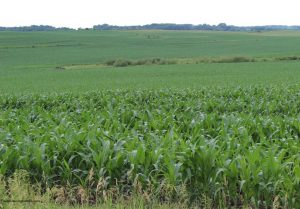A report by the Minnesota Pollution Control Agency found that nitrogen in surface waters, a possible human health issue, is caused by agricultural runoff. Levels are particularly high in southern Minnesota.
 More than 70% of nitrates in surface water come from cropland. Anhydrous ammonia is used as a fertilizer on farm fields. Drain tiles, which carry away excess water that can cause crops to rot, carry the chemical to streams and rivers. The nitrate then travels downstream, where a huge dead zone of oxygen-deprived water has formed in the Gulf of Mexico.
More than 70% of nitrates in surface water come from cropland. Anhydrous ammonia is used as a fertilizer on farm fields. Drain tiles, which carry away excess water that can cause crops to rot, carry the chemical to streams and rivers. The nitrate then travels downstream, where a huge dead zone of oxygen-deprived water has formed in the Gulf of Mexico.
Nitrate consumption can cause methemoglobinemia, or “blue baby syndrome“, in which infants develop a blue-gray skin color and become irritable or lethargic. This condition can cause death if not quickly treated. Some adults who are susceptible to nitrates because of illness, pregnancy, or exposure to antioxidant medications, can also develop this disease when exposed to higher concentrations of nitrates in drinking water. At higher levels (100 to 200 mg/l nitrate-N), nitrates combine with amines in the body to form cancer-causing substances.
Increased using of draining tiling is one reason for the problem. Precipitation amounts can change the amount of nitrates getting into surface water. During a wet year, loads can increase by 51%. Farmers can manage nitrate loads by diversifying vegetation and planting cover crops, manage and treating tile drainage water, and managing in-field nutrients. A state-level nutrient reduction strategy is being developed to address Minnesota’s contribution to the hypoxia issue in the Gulf of Mexico. Minnesota contributes to the sixth highest nitrogen load to the Gulf.




